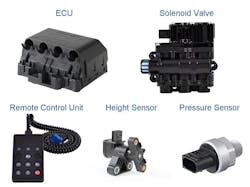WABCO–a supplier of braking, stability-control, suspension, and transmission automation for commercial vehicles–reports that major Chinese manufacturers continue to increase the adoption of its OptiRide electronically controlled air suspension (ECAS) system in series production of heavy-duty trucks and buses. WABCO is the only supplier of ECAS for truck and bus manufacturers in China including China National Heavy Truck Corporation (CNHTC), Dongfeng Liuzhou Motor Company (DFLQ) and Shaanqi.
OptiRide ECAS technology is an alternative to steel-spring suspension that improves fuel economy up to 3% under certain conditions and enables wider control of vehicle chassis height and levelness. It quickly responds to operator commands, such as lifting and lowering one or both ends of the vehicle chassis in relation to its wheel axes. An electronic control unit (ECU) sends commands to solenoid valves that precisely control air flow to individual suspension bellows at the wheel axes. The ECU also responds to feedback from height and pressure sensors to continuously send air-flow commands to the solenoids and ensure smooth riding—even on rough roads.
Chinese manufacturers are also including OptiRide in their advanced-vehicle platforms because of its automatic load transfer (ALT) function that mitigates any axle overload to improve operational costs by minimizing axle wear. ALT will even activate during sudden axle overloading, such wheel slippage on wet roads. When the advanced brake system detects any slippage, OptiRide will transfer pressure to the drive wheel to increase its traction and so the driver can regain a hold on steering.
“Leading Chinese truck makers are increasingly upgrading their vehicle platforms and axle configurations to be more competitive for long-haul transport and logistics operations,” said Sujie Yu, WABCO Vice President, Asia Pacific. She also mentions OptiRide’s capabilities to improve vehicle efficiency and safety, while enhancing the driver’s comfort.
Major components of OptiRide include the ECU, height sensors, pressure sensors, a solenoid valve block, and a remote controller. The ECU reads data from up to four height sensors and five pressure sensors. Height sensors are mounted onto the vehicle chassis and connected by linkage to the axle housing to provide ride height information. Pressure sensors are connected to the suspension bellows. The solenoid valve block has electrical connections to the ECU and airflow connections to the suspension air bellows.
The remote control unit is connected directly to the ECU so that the operator can control the vehicle frame height, particularly during loading and unloading, or connecting to a trailer. The operator can also return the vehicle to a normal riding level, stop all OptiRide functions, and preset up to two separate baseline chassis heights.



